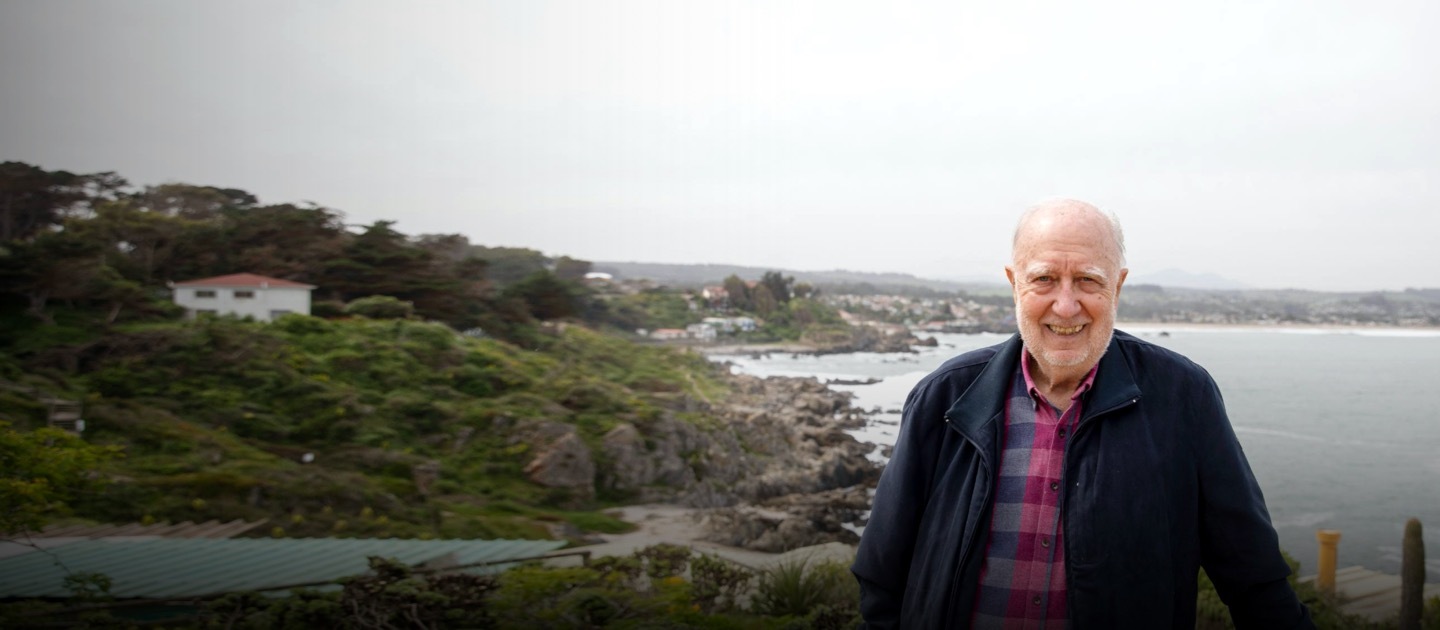
Researcher Juan Carlos Castilla Highlight ECIM as a Beacon for Marine Conservation
Established four decades ago in Las Cruces, UC Chile Coastal Marine Research Station (ECIM) emerged in response to the need for a dedicated hub for marine research. Driven by scientific curiosity, the Station became a pioneering untouched marine area in Chile, revealing the impact of human activities on the ecosystem. It also played a crucial role in shaping the Areas of Exploitation and Management of Benthic Resources model, which was later integrated into the 1991 Fisheries Law. In a recent interview, Juan Carlos Castilla, the founder, reflected on the inception of the ECIM and articulated his vision for the future: cultivating a marine culture within the country.
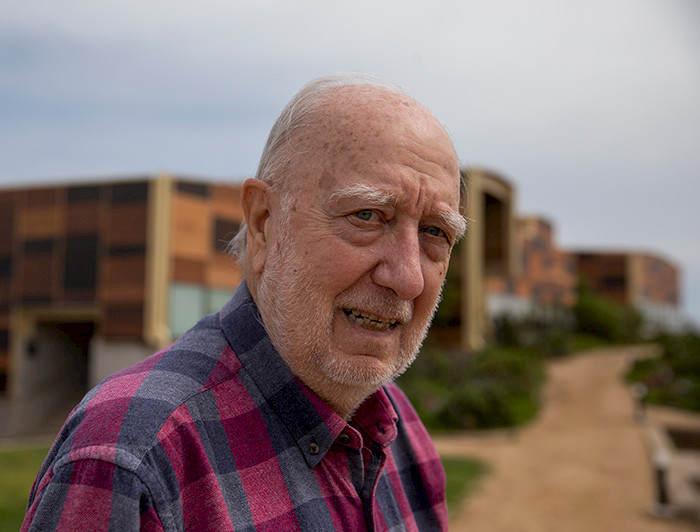
photo_camera "If I want to have the exclusivity to conduct science in a coastal zone without human impacts, I have to take care of it; I have to give back the knowledge obtained to the community," asserted ECIM's founder and first director, Juan Carlos Castilla, regarding the public role of research. (Photo by: Karina Fuenzalida)
The interview started with me asking about the rationale behind establishing a marine research station in Las Cruces. My interviewee was Juan Carlos Castilla, a distinguished figure who won the 2010 National Prize for Applied and Technological Sciences and has been a professor at the UC Faculty of Biological Sciences for over five decades. Seated across from me, with the magnificent Pacific Ocean as the backdrop, I inquired further, "How did the idea come about?" to which he neatly responded, "Out of necessity."
We were sitting in front of the modern building that houses the Coastal Marine Research Station (ECIM, by its Spanish acronym)—part of the Network of Regional Centers and Stations (RCER UC, by its Spanish acronym) of UC Chile—which will celebrate its four-decade mark this year. Professor Castilla took us back to the origins, long before the Station was conceived: "Upon our return to Chile, a group of international doctoral students specializing in marine biology started conducting research in marine ecology at the University's Casa Central, located at Alameda and Portugal, right in the heart of Santiago." So, they started to explore the coastal regions, using the central and central-north areas of the country as one of their bases of operations.
The Research Question
From 1975 to 1980, amid the crisis in artisanal fishing triggered by excessive extraction from divers and shore shellfish harvesters and the unrestrained opening of international seafood markets, a pivotal realization emerged among fisherfolk. "They recognized the unsustainable nature of continuing to extract stocks at the previous rate," noted the researcher, adding: "I was interested in understanding, through scientific research, the structural dynamics of these ecosystems and derive scientific and fishery management insights."
This marked the juncture where human involvement became a critical factor in the equation. "We were just another participant, neither good nor bad. I wanted to understand how humans interacted with natural communities and to what extent those interactions were causing different dynamics." Castilla discovered in Los Molles and the small cove of Hornos that merely shifted one kilometer north, away from human habitation, which increased the quantity and size of resources. "That's when my curiosity about the impact of human activity on these systems intensified," he recalled.
"But we had no laboratory or natural protected coastal facilities to perform the experiments. So the urgent need for protected coastal facilities for research became evident."
The Search
With the backing of the University, then led by UC Chile President Jorge Swett, and funding from the Canadian agency International Development Research Centre (IDRC), Juan Carlos Castilla and his mentor Patricio Sánchez embarked on a quest to find suitable land to build a marine station dedicated to scientific purposes.
Their journey covered a significant stretch of the central coast of Chile, traversing from Santo Domingo in the south to Papudo in the north within the Valparaíso region, all aboard an old Land Rover. The selection criteria were multifaceted: the site had to be within a 200 km radius of Santiago for practical commuting, situated in a relatively pristine area with minimal human impact, available for purchase or concession, and ideally have a rocky headland.
"Why?" I asked. "Because rocky headlands are unique in Chile: they are highly productive. The substantial swell and desired resources—such as Chilean abalone, sea urchins, or commercial algae—alongside local fisherfolk made them particularly valuable."
After a year and several unsuccessful attempts, the search proved fruitless until a visit to Las Cruces revealed that the perfect location had been right under their noses all along.
The chosen site, known as "Punta del Lacho" (Lover's Point), met virtually all specified conditions and supported numerous prior observations and experiments. Castilla added a touch of local insight, noting that the area was called "Punta del Lacho" because couples often visit the place to witness one of the "best sunsets in Chile."
The Station
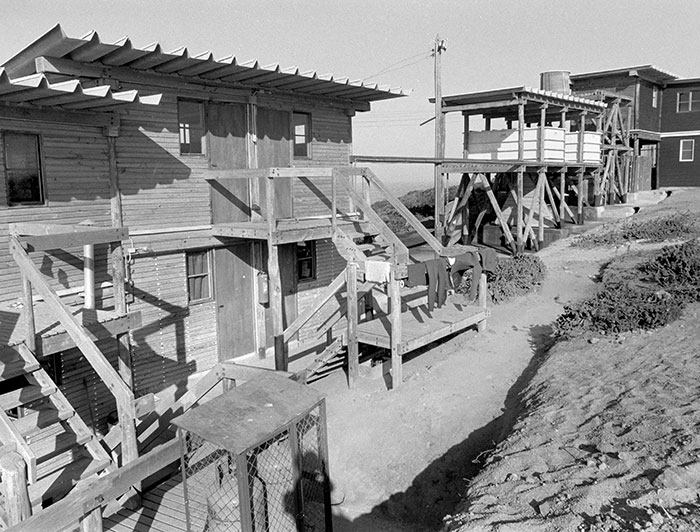
We began with nothing - no homes, no access to water, and no electricity. In about seven to eight months, they built the first Station, "a bunch of sticks piled on top of each other," as recalled by Juan Carlos Castilla, the inaugural director who served for 14 years. The initial construction covered a modest area of less than 300 m2, primarily focusing on seawater extraction. A tower with a capacity of 4,000 liters facilitated water circulation for ponds crucial to housing marine species and conducting observations. For Castilla, the genuine laboratory was among the rocks.
One of the early actions involved perimeter closure, adding fences to the north and south edges. While permission delays prompted a direct approach with fisherfolk, they eventually obtained permits to extend into the sea.
The objective was to observe marine resources in an environment free from human intervention. Due to their familiarity with and prior research in the area, they had the knowledge and information necessary to compare the two periods—before and after the closure. "We began compiling a database that has been around for more than 40 years."
This marked one of Chile's first instances where an area was shielded from human intervention, involving systematic data collection before and after the exclusion. Consequently, less than one square kilometer of this coastal area emerged as one of Chile's pioneering marine protected areas.
The Model
Initially challenging, it took until the fifth or sixth year to commence the procedures for establishing a marine reserve. Despite being a coveted spot for fisherfolk, over time, they recognized the advantages of excluding Punta del Lacho. "Post-closure, they observed a resurgence of species such as Chilean abalone, sea urchins, limpets, and pejesapos, whose populations not only rebounded but, in some cases, surpassed their previous numbers." Juan Carlos Castilla emphasized, "This was evidence of the impact humans were having."
This is the birthplace of the Benthic Resources Management and Exploitation Areas (AMERB, by its Spanish acronym), a model of significant importance in national artisanal fisheries and a global example of a fisheries co-management system. "We tried to persuade authorities that if communities were involved in these areas, they could protect them autonomously. "At the time, there was no Congress and no Fisheries Commission during the dictatorship. But we convinced the Institute for Fisheries Development (IFOP by its Spanish acronym) and other government officials that it was a feasible model to implement, backed by the outcomes from ECIM and a couple of artisanal coves."
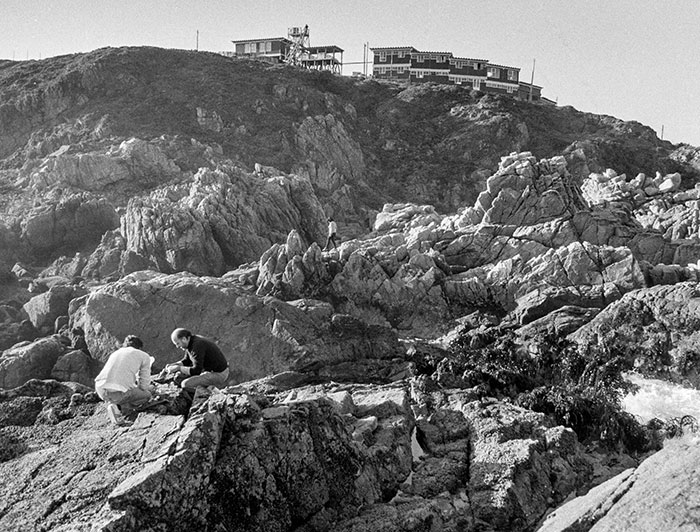
Juan Carlos Castilla launched the project between 1987 and 1990, funded by the Canadian agency and supported by Fondecyt (National Fund for Scientific and Technological Development). The goal was to transition "from the small, ideal world of researchers in Las Cruces to the real world of artisanal fisherfolk and corroborate the experiences with them using pre-existing experimental information."
Arriving at Quintay and El Quisco, both well-organized coves with robust leadership, Juan Carlos Castilla engaged with the fisherfolk. "We conveyed our intention to lobby fishing authorities for their exclusive access to abalone extraction in a designated area of 50-100 hectares. It would be a collaborative effort to demonstrate the management potential of an area jointly worked by fisherfolk and technicians," he explained. Emphasizing the importance of bestowing fisherfolk exclusivity in loco extraction management, he humbly stated, "It was crucial to work together because fisherfolk have a wealth of knowledge that surpasses that of scientists."
How does it work? According to Juan Carlos Castilla: "It's the opposite of a ban. We aren't simply abstaining from harvesting Chilean abalones for five years. Instead, we are planning a thorough and well-structured harvest based on the abalone population in the AMERB seafloor. The cove's union members are working to establish the exact amount to be extracted." The concept involves rotating extraction areas within the AMERB, fostering natural repopulation processes.
This was a pioneering effort in Chile, with very few similar examples worldwide, and not all proved successful.
The experiment was successful. "The fisherfolk were the best stewards of their area," he affirmed, noting the triumph of integrating the co-management extractive model into the 1991 Fisheries Law, complete with an article detailing the AMERB model. Years later, the outcome was the establishment and operation of numerous AMERBs nationwide, engaging over 25,000 fishermen. Describing these areas as co-management, he highlighted the extraordinary theoretical and practical advancements achieved.
He added emphatically: "I want to applaud the Chilean fishermen; they have a marine culture that we lack. We, in contrast, are blind to the sea. While we may see only the surface, those in their workplaces truly understand what lies underneath. I take pride in the Andes; it's an essential part of my culture. Nevertheless, for something to become a culture, it must be visible to the masses. Unfortunately, in Chile, marine education is not integrated into school programs. We not only turn our backs on the sea but fail to recognize it as an integral part of our culture."
The Station's Role
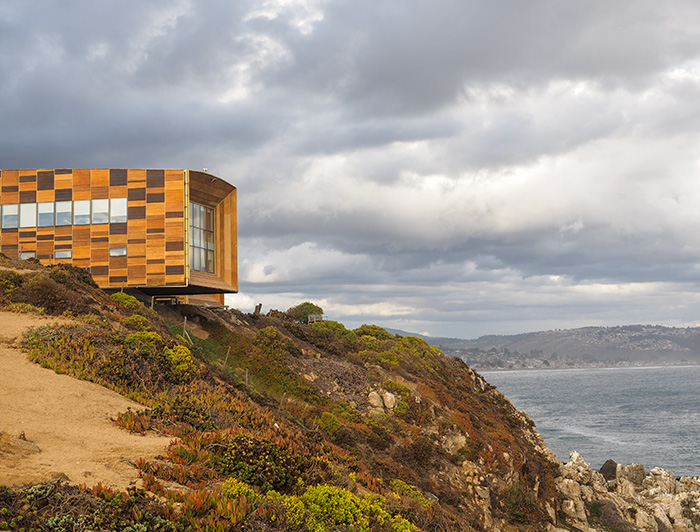
The exclusion of humans from a protected area was key to understanding the system's dynamics by eliminating a key variable: fisherfolk. This has allowed the Station to make significant strides in understanding the status of resources, the ecology, and the broader ecosystem. As the researcher noted, "It wasn't just abalones and sea urchins that increased. After 12 years, seagulls began to nest."
The exclusion of humans from a protected area was key to understanding the system's dynamics by eliminating a key variable: fisherfolk. This has allowed the Station to make significant strides in understanding the status of resources, the ecology, and the broader ecosystem. As the researcher noted, "It wasn't just abalones and sea urchins that increased. After 12 years, seagulls began to nest."
However, they also observed another phenomenon: "Within the ECIM, biodiversity suddenly decreased in the rocky areas, where there is no human intervention. Why? We began to understand the direct and indirect biological interactions, which is precisely what ecology is all about! When we started the ECIM, there were 0.05 abalones per square meter. Five years later, the average increased to 2 or 3 per square meter. The abalones began to consume their typical prey, such as Mytilus (Chilean mussel), within which a vast biodiversity resides. It turns out that when humans are removed from the system, the abalones increase their population density, and they start feeding on their prey, temporarily eliminating it from the ecosystem. And, in that context, there is no predator to control the Chilean abalone," he explained.
However, understanding these dynamics takes decades. The Station's uninterrupted monitoring for over 40 years is unique and immensely valuable. "From a marine conservation perspective, the ECIM has evolved into a beacon for marine conservation," remarked Juan Carlos Castilla.
The professor underscored the pivotal role the Station has played in advancing marine conservation, emphasizing that it has done so within the communities where people reside, acknowledging that this presents a more significant challenge than working in remote, less populated areas. Castilla also highlighted achievements such as student training, interdisciplinary collaboration, establishing a distinctive artisanal fishery management model, and publishing hundreds of scientific articles to disseminate the developments.
He emphasized the Station's public role, stating, "If I want to have the exclusivity to conduct science in a coastal zone without human impacts, I have to take care of it, I have to give back the knowledge obtained to the community," He highlighted the educational efforts of the ECIM over the last decade, especially through the "Chile es mar" program led by his successor, Sergio Navarrete, and Professor Miriam Fernández. Since 2012, an average of 3,500 children per year have visited ECIM's mini aquariums to learn about the sea, although the pandemic temporarily halted this initiative. He regrets that no significant projects foster marine cultural awareness and advocates for a substantial effort to develop a maritime culture in Chile.
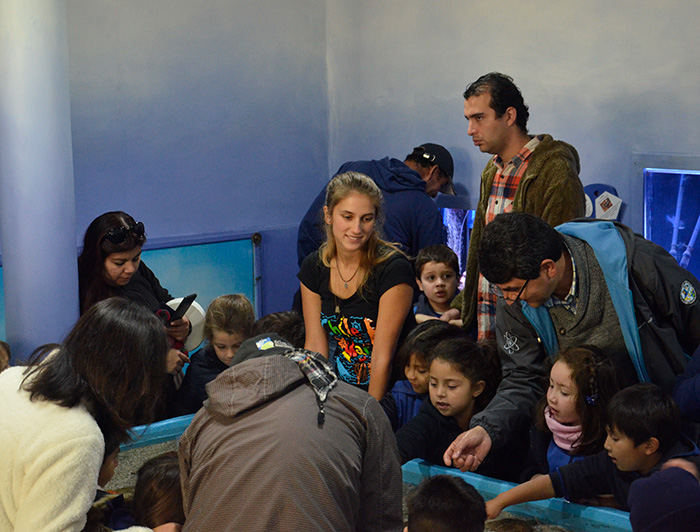
He also emphasized the continuous support from UC Chile, including university presidents and deans of the Faculty of Biological Sciences, throughout ECIM's existence. He appreciated their extraordinary support, highlighting the importance of commitment and mutual credibility for sustaining such a project. He passionately expressed that this University, where he studied and developed as a scientist, holds a special place in his heart, not only in Las Cruces but also in the broader University community.
"Professor, how do you envision this station in ten more years?" I inquired. "I don't see it growing all that much. I would rather say: I have a good infrastructure here... what can we do with it? I believe it's crucial to seek mechanisms to strengthen emerging research avenues and aspire to become a Latin American leader in marine conservation. Despite significant progress already made in this regard, I also envision it becoming more multidisciplinary."
Finally, with a twinkle in his eyes, he said: "I envision much more marine education. I imagine a mini aquarium for children, which could be visited annually by 3,000-4,000 children; they could not only look and marvel at the marine species but also touch, learn, and experiment. I envision a structured program with follow-up in schools—an initiative that currently does not exist in Chile. It's not about constructing massive buildings but rather about obtaining sustainable funding. My dream is to create a marine culture in Chile, starting with children in schools."


